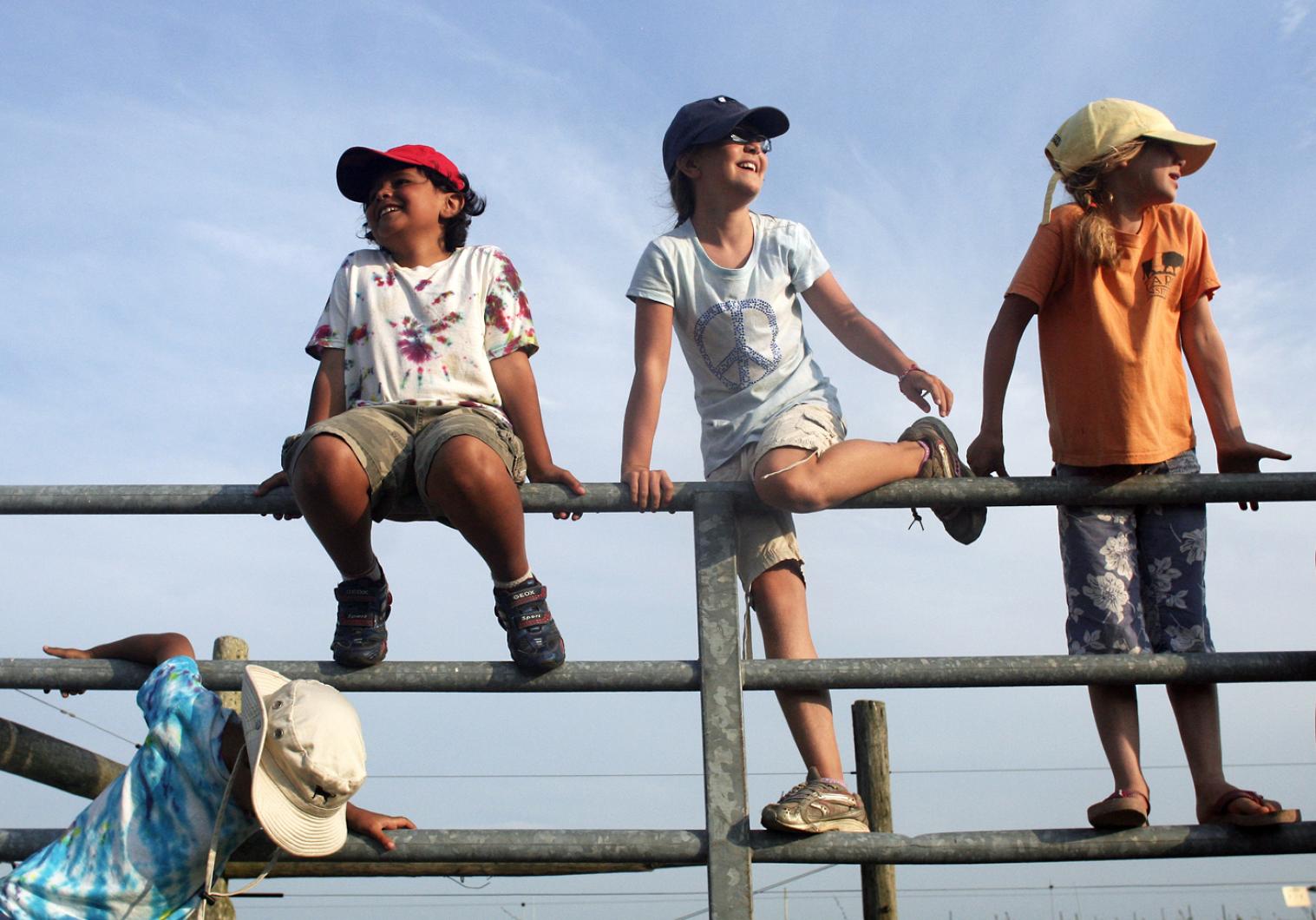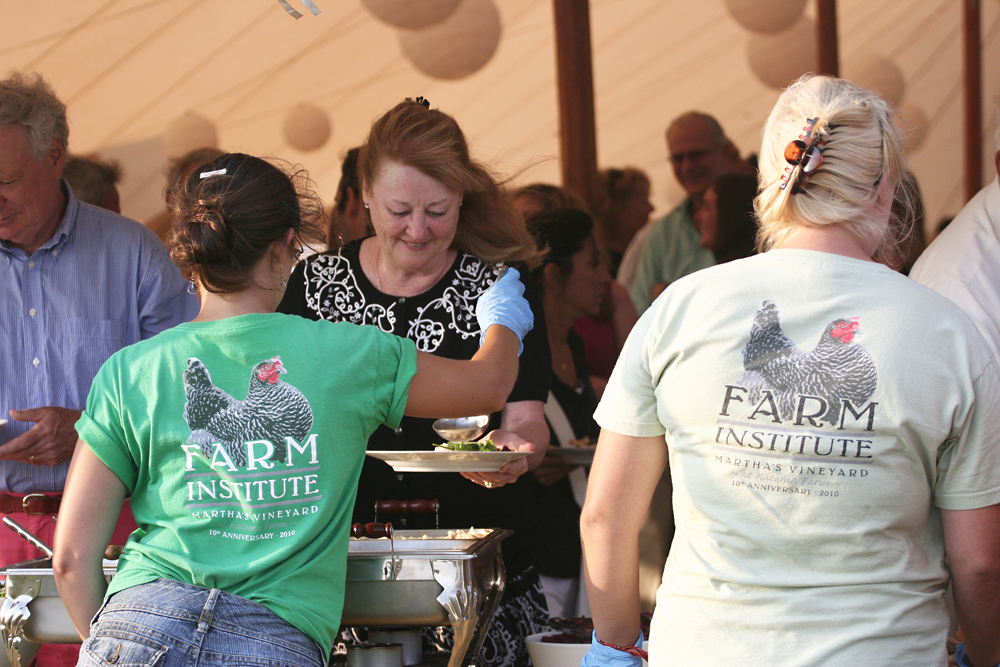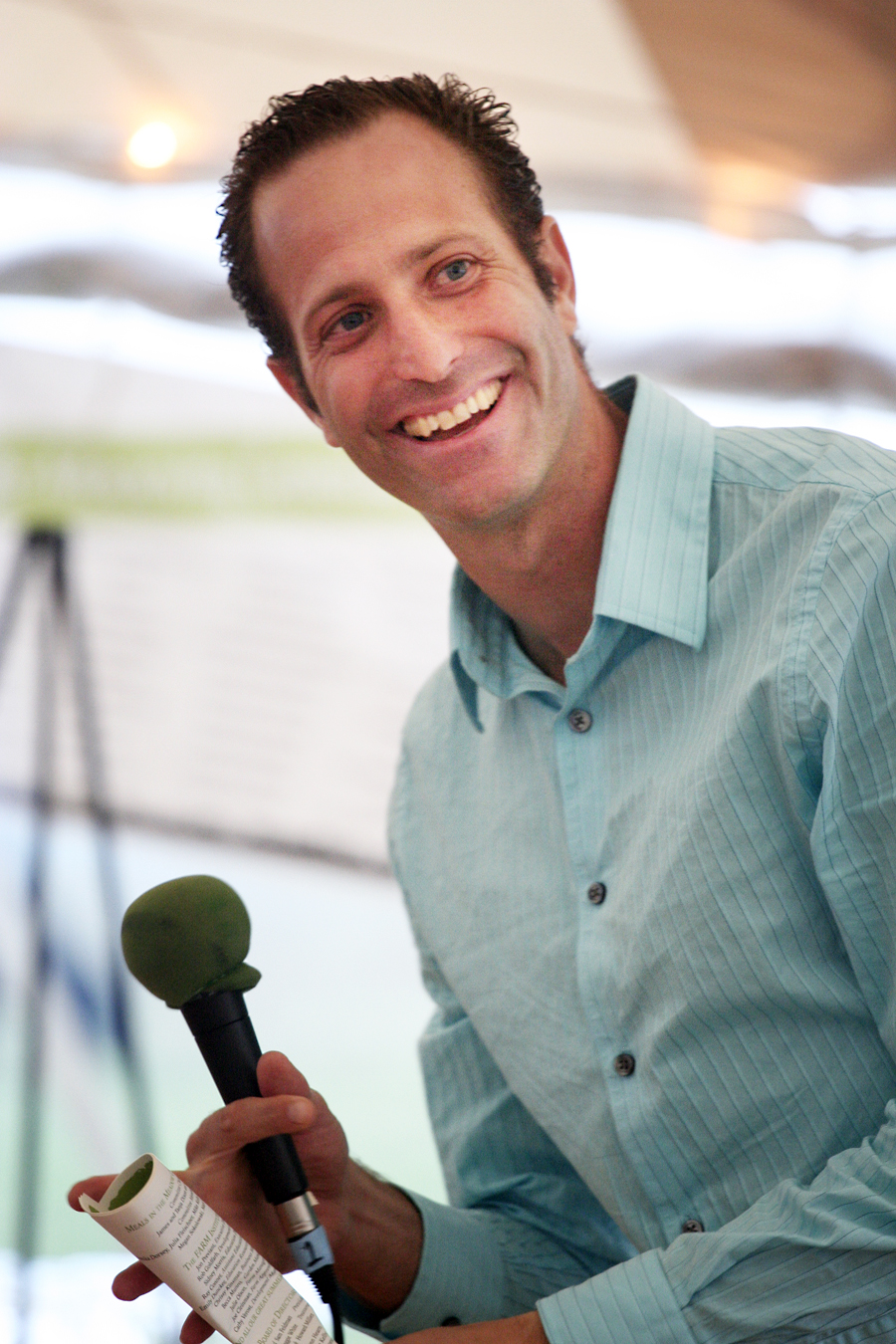Hay bales in the distance, belted Galloways grazing in the fields, the sun setting softly over Katama Farm — it was a picturesque Vineyard evening for the Farm Institute’s Meals in the Meadow event Saturday night that was full of local food, drink, fun, and most importantly, education. The annual fundraiser was held to raise money for the institute’s education programs that teach children and adults sustainability through farming practices.
This year’s sold-out event spanned generations, as parents and campers, grandparents and counselors came together for one evening beneath the tent lit by lanterns. Dickie Brown has been to the event every year. With his cowboy hat, suspenders and boots, Mr. Brown pointed to his 1938 John Deere tractor that’s still in use at the farm. On Saturday evening campers were resting on it as the sun began to set on their rosy faces. They were all smiles.
Guests were serenaded into the tent by a guitar player, followed by new executive director Jon Previant. “It feels like being home,” Mr. Previant said. “It’s an old and comfortable feeling because of the farm. But on the other hand I didn’t know we did all of this stuff.”
Mr. Previant was looking forward to meeting the generous people who support the institute’s programs and thanking them. “It’s about showing people what it is that we do,” he said. “We’re a working farm. We teach and we do.” Mr. Previant, who took the top post at the farm just a few weeks ago, thanked the “outrageously competent” staff for their help. “They already know how to ignore me,” he said, smiling. “They need little direction.”
Mr. Previant was one of three institute members interviewed by NPR’s All Things Considered host Michele Norris; the other two were farm manager Julie Olson and a nine-year-old camper named Noah. Ms. Norris, who held an All Things Considered style interview session at the Farm Institute with the three, has been a farm family member since last summer when she sent her two children to camp.
“My kids were there . . . and we fell under the spell of its charm and mission,” the NPR host said from her Washington, D.C., office earlier this week. “I want to help people in the audience understand . . . what they do for the Island and how that experience stays with people.”
Ms. Norris has been coming to the Vineyard for nearly 20 years, but coming from a city meant the closest her kids got to a farm was through children’s books. “It’s really important for me that they got to know the experience on a farm, and now have a better idea of where their food comes from,” she said.
When her kids came home asking to have leeks and kale for dinner, it was music to her ears. “We all need to stop and think where our food comes from, what we are putting on the table, and how we are feeding our families,” she said.
Emily Duncker, education resources coordinator, taught just that on Saturday night, at one of the institute’s “farm-o-ramas” (like a diorama) where institute teachers hosted eight different workshop events centered around their programs.
“It’s really important for everyone to know what we’re doing, not just the kids . . . so the parents get to learn too,” Ms. Duncker said. Interactive themes included soil, animal production, grass, plants, cooking and nutrition, farming machines, conserving and preserving, and food and farming from around the globe.
Campers and counselors spent the week before the event getting ready for their presentations. One table had a “name that seed” game, another instructed you on how to make homemade charcoal and what the benefits were, and another taught you how to make homemade grain.
“The event is better every year because it’s more and more about the farm,” farm manager Julie Olson said, adding: “We have great kids here and I’m glad the farm-o-ramas are forcing people to be interactive.”
The event stayed as local and sustainable as possible, both with food and Island traditions. “We want a sensation of having people really value what we do,” Rob Goldfarb, development director, said earlier this week. “We always go to our Island to promote Island businesses first and are finding ways to work together.”
Four pigs were served to guests, along with fresh succotash, mashed potatoes, baked beans, chicken from the farm and salad, as well as organic tequila from Casa Noble. Flatbread Pizza trucked in a portable stone oven and were making pies all night long with organic products, while Jan Buhrman’s Kitchen Porch was hand-stretching homemade mozzarella for appetizers. It was a hardy meal for a hardy crowd.
Mr. Goldfarb noted the “Vineyard-esque auction items that keep traditions and cultures on the Island” such as a wedding at the Captain Flanders House, having chickens lay eggs at your home for a week and a dance party with the night’s entertainment, Johnny Hoy and the Bluefish. Two separate families bid $10,000 each to be serenaded by the band.
“It’s always fun and a really good cause,” Julie Flanders of the Captain Flanders House said. “Every year it’s a great event.”
After the auction, guests joined arm-in-arm, kicking up their cowboy heels to the music of Johnny Hoy.
“It’s very much a community oriented event,” Mr. Goldfarb said. “This is about you!” he told the crowd, adding that it’s an “important education to know the value of the food community and why farms matter . . . your kids are the future land stewards.”
And although this is his last Meals in the Meadow, as he leaves the institute this year, Mr. Goldfarb’s departure is much more sweet than bitter. “I’ve been with them for five years; to see how far it’s come is due to everybody,” Mr. Goldfarb said. “It wasn’t one cow or one sheep . . . my only hope is that people will continue to show their support for what the farm is and what it will become,” he said. “I’m confident that it will continue to grow.”
Bill Connolly, a board member who served as interim director this year, spoke to the crowd about his experience with the farm. He noted the earthy scent of the farm wafting over the tables as the fog began to roll in.
“Those of us who have been around for all 10 years can barely believe it,” Mr. Connolly said. “With 3,000 students and adults over the years, the fields have been brought back to life.”









Comments
Comment policy »